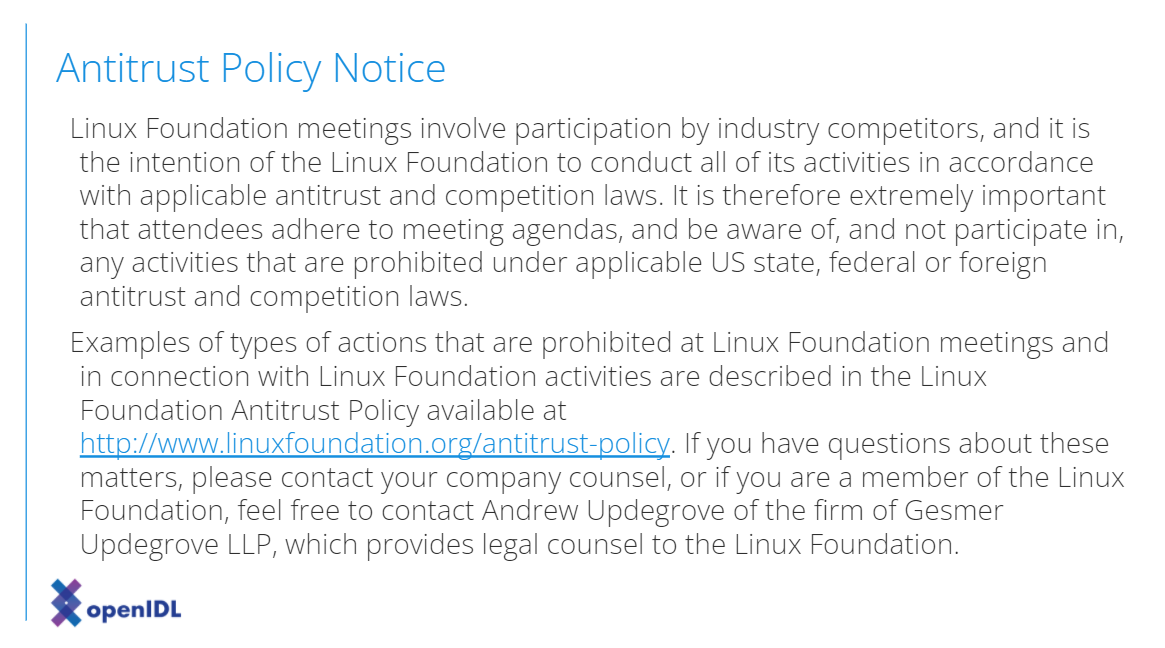openIDL Navigation
Date
Attendees
This is a weekly series for The Regulatory Reporting Data Model Working Group. The RRDMWG is a collaborative group of insurers, regulators and other insurance industry innovators dedicated to the development of data models that will support regulatory reporting through an openIDL node. The data models to be developed will reflect a greater synchronization of data for insurer statistical and financial data and a consistent methodology that insurers and regulators can leverage to modernize the data reporting environment. The models developed will be reported to the Regulatory Reporting Steering Committee for approval for publication as an open-source data model.
openIDL Community is inviting you to a scheduled Zoom meeting.
Join Zoom Meeting
https://zoom.us/j/98908804279?pwd=Q1FGcFhUQk5RMEpkaVlFTWtXb09jQT09
Meeting ID: 989 0880 4279
Passcode: 740215
One tap mobile
+16699006833,,98908804279# US (San Jose)
+12532158782,,98908804279# US (Tacoma)
Dial by your location
+1 669 900 6833 US (San Jose)
+1 253 215 8782 US (Tacoma)
+1 346 248 7799 US (Houston)
+1 929 205 6099 US (New York)
+1 301 715 8592 US (Washington DC)
+1 312 626 6799 US (Chicago)
888 788 0099 US Toll-free
877 853 5247 US Toll-free
Meeting ID: 989 0880 4279
Find your local number: https://zoom.us/u/aAqJFpt9B
Hicham Bourjali
Brian Hoffman
Michael Payne
Sandra Darby
Jenny Tornquist
Allen Thompson
Lanaya Nelson
Reggie Scarpa
Minutes
I. Introductory Comments
II. Official Business
A. PA: this week we looked at commercial auto
- Tracked down some test data; looked at stat plan
- Using same stat plan as personal auto but 2 columns interpreted differently.
- Personal has private passenger/penalty points
- Commercial automobile classification/use (line 35)
- JM: key question. Concept where two lines are similar are different. Multiple ways to solve it.
- Multiple disparate concepts in same table but accrue sparsity problem
- Covered vehicle - VIN - same for both. Premium also common/universal - but what of four (or so) non-common columns
- Most people prefer flatter, wider tables - unless there is a reason not to.
- If the sparsity problem is broad, we may want to start breaking up tables in that instance.
- DR: one auto file right now that is personal and commercial. Longer term we will have many in personal that we don't want in commercial and vice-versa.
- JM: a business question - how many attributes will business model put on this over time? How many commonalities and variances are there? And architecturally do we spread this out?
- JT: business report has both commercial and auto on it.
- JM: we must look at other fields to determine whether initial field values are personal or commercial auto. This is something we generally want to avoid. Embedded rules are going to be confusing to consumers of data.
- PA: in building extraction pattern, started off with just personal auto. Currently an auto policy and policy claim table combined. If we broke commercial out into its own thing it wouldn't really change the extraction or merge process.
- JM: agreed - his recommendation is pull these out (commercial). Avoid embedded rules.
- PA: interpretability will be the same; we are eliminating the sparsity.
- PA to JM: We have no embedded rules.
- JM: should we live with reasonable sparsity? This is a business decision - we should have a threshold however. (No more than a dozen items each?)
- PA: wants to revisit this equation next week after he reviews the categorizations and gauges which do or don't apply to sparsity.
- PA: wants to ensure that we have the proper raw tables to fulfill our own business needs. If we break out commercial auto into its own entity now, that's an easy move, and will help us avoid problems later on.
- JM: agrees that separating them out (bottom up - as we encounter it, we do it) for "cleaner" results. However wants to have the discussion in the case of each line "where do we see this going?" In other words, having a vision discussion (anticipatory).
- DH: on the commercial side we aren't necessarily tying a driver to the vehicle. But are insuring the vehicle, not the person (identified through VIN, not DOT #). On personal side, they assign a driver but this is not necessarily how rating is determined/applied.
- JM & DH: we are limiting selves to 1 driver/vehicle because of stat.
- DH: also keeping personal and commercial separate because of the fact that we have combined ratings.
Discussion items
| Time | Item | Who | Notes |
|---|---|---|---|
Action items
Overview
Content Tools
